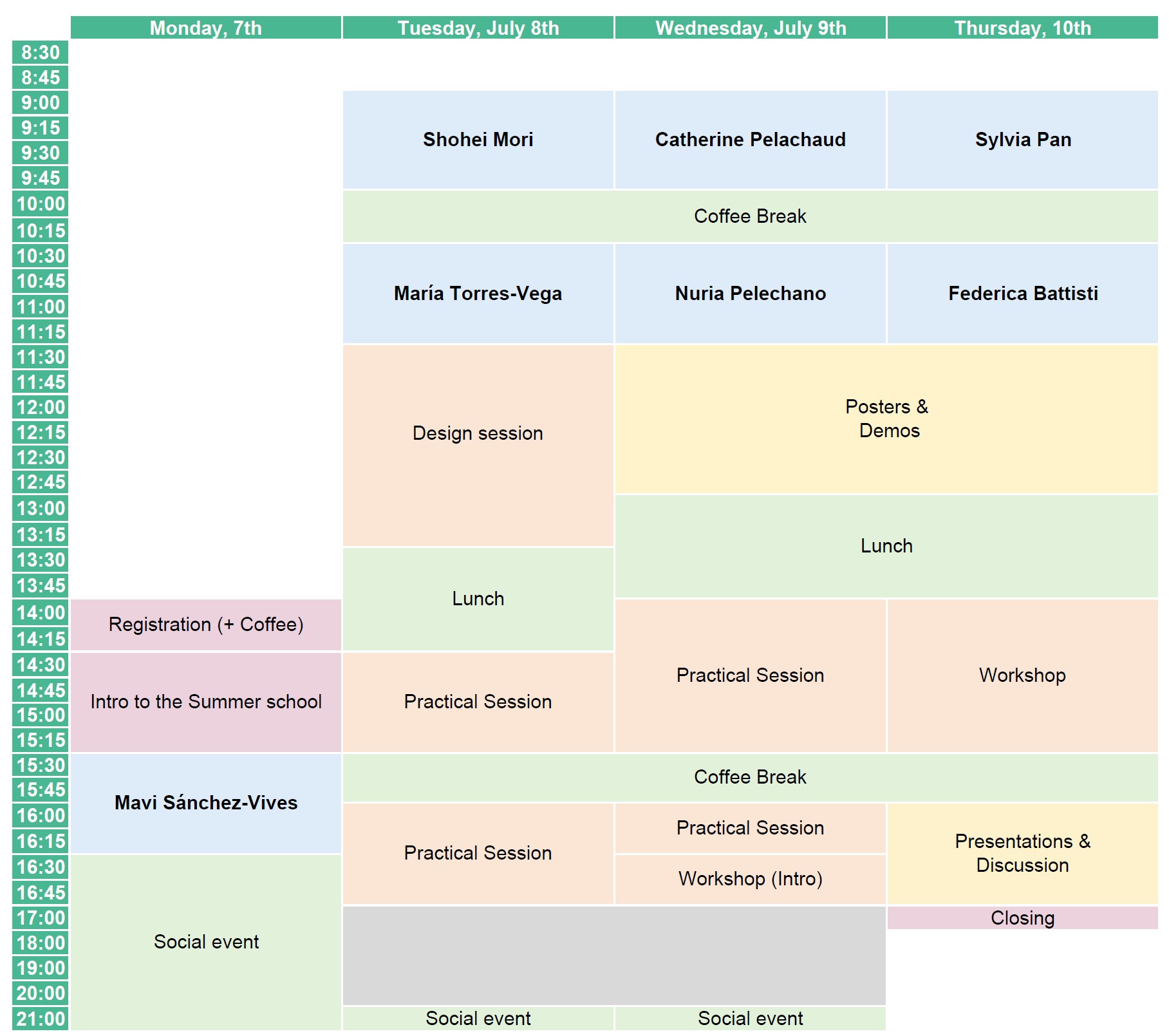Program

ABSTRACTS
Novel VR Approaches for Chronic Pain Relief
Mavi Sánchez-Vives
The phenomenon of virtual embodiment—the illusion of owning a virtual body—is at the heart of our approach to pain management. Our previous work has shown that both the ownership and transformation of a virtual body can modulate pain thresholds in healthy individuals. Furthermore, we have demonstrated that alterations to a virtual body, such as skin colour or size, can significantly impact pain perception across a spectrum of chronic pain conditions, including peripheral nerve injury, complex regional pain syndrome, or fibromyalgia. This presentation will detail our development of a state-of-the-art, personalized virtual environments tailored for chronic low back pain. A prototype, evaluated in 100 patients, has yielded encouraging results in pain reduction and patient engagement. Additionally, we will discuss the transformative potential of shared virtual environments for fostering patient communities and facilitating group therapy, offering a new avenue for both designing and delivering ongoing therapeutic support. These immersive environments represent a step forward in creating personalized, scalable, and effective treatment strategies for chronic pain.
Modeling and Evaluating Socially Interactive Agents
Catherine Pelachaud
Socially interactive agents often have a human-like appearance and are modeled to communicate with their human interlocutors through verbal and nonverbal means. During an interaction, participants exhibit different adaptation mechanisms, which can take many forms, from signal imitation to synchronization and conversational strategies. Adapting the multimodal behaviors of a socially interactive agent to the behaviors of its human interlocutors can promote engagement, build rapport and trust, and support the learning process. In this lecture, I will introduce various computational approaches to generate communicative and socio-emotional behaviors to convey intentions and affect. I will also describe several experimental methods to validate these approaches. Objective and subjective measures will be introduced. I will present the open-source system Greta, which allows modeling human-agent interactions. I will conclude the lecture by indicating future lines of research.
From metrics to users: understanding QoE in Extended Reality
Federica Battisti
Extended Reality is rapidly transforming the way we interact with digital content and physical environments. As these technologies advance, the key to their broad adoption lies in understanding and optimizing the users’ Quality of Experience (QoE) that accounts not only for system performance, but also perception, interaction, comfort, and engagement. This keynote will explore the evolution of the concept of QoE in XR. We will discuss how traditional QoE concepts are being redefined in immersive environments, and examine the unique challenges that XR introduces such as multisensory integration, and motion-related discomfort. Drawing on recent research and practical examples, we will investigate how engineering methods can be applied to measure, analyze, and improve user experience across the XR pipeline. The goal is to provide participants with a clear understanding of the key dimensions of QoE in XR, and to highlight how an interdisciplinary approach, including systems, human factors, and design, can lead to more effective and impactful immersive experiences.
Animating Virtual Humans to improve trust, co-presence and embodiment
Nuria Pelechano
The metaverse is rapidly evolving as a new playground for interacting and collaborating with other autonomous agents or avatars controlled by other users. In the real world, there are many aspects of nonverbal behavior and appearance, that influence the way we communicate and build trust with others. Since most communication in the metaverse will be through virtual humans, there is a need to understand how different aspects of these virtual avatars can affect the quality of such interactions and allow us to build trust and enhance co-presence. In this talk, I will focus on simulation and animation aspects that play a critical role in creating engaging virtual humans in VR. I will cover both simulation and animation of groups of autonomous agents interacting with the user, as well as self-avatars representing the user. When interacting with with a group of agents, I will show how incorporating collision beliefs, audio, or vibro-tactile feedback can enhance co-presence and the overall plausibility of the virtual experience. When it comes to our self-avatar, animation quality and multi-sensory feedback can affect embodiment, task performance, and even change our own body image. Finally, I will present some motion reconstruction techniques that can take advantage of current AI trends to provide high quality animation even with few tracking sensors.
XR Meets Radiance Fields
Shohei Mori
Radiance fields (RF), including Neural Radiance Fields (NeRF) and 3D Gaussian Splatting (3DGS), have revolutionized interactive and photorealistic view synthesis. This paradigm shift invites us to rethink how we capture, store, edit, and replicate the real world in an immersive environment, and how these capabilities might reshape the future of XR ("X" representing any type of reality). Riding the wave of "hyperrealism" hype, this keynote reflects on past and present developments in XR enabled by RF technologies, revisits what recent advances in RF have brought us, analyzes emerging trends, and explores future opportunities and open challenges to be ready for the transformative potential of RF in immersive technologies.

